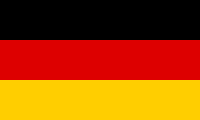Banner o Germany
The "Scots" that wis uised in this airticle wis written bi a body that haesna a guid grip on the leid. Please mak this airticle mair better gin ye can. |

The banner o Germany is a tricolour consistin o three equal horizontal baunds displayin the naitional colours o Germany: black, reid, an gowd.
The black-red-gowd tricolour first appeared in the early 19t century an achieved prominence during the 1848 Revolutions. The short-lived Frankfurt Parliament o 1848–1850 proposed the tricolour as a banner for a unitit an democratic German state. Wi the formation o the Weimar Republic efter Warld War I, the tricolour wis adoptit as the naitional banner o Germany. Follaein Warld War II, the tricolour wis designatit as the banner o baith Wast an East Germany. The twa banners wur identical till 1959, whan the East German banner wis augmentit wi the coat o airms o East Germany. Synee reunification on 3 October 1990, the black-red-gowd tricolour haes remained the banner o Germany.
The banner o Germany haes no aaways uised black, red, an gowd as its colours. Efter the Austro-Proushyan War in 1866, the Proushyan-dominatit North German Confederation adoptit a tricolour o black-white-red as its banner. This banner later became the banner o the German Empire, formed follaein the unification o Germany in 1871, an wis uised till 1918. Black, white, an reid wur reintroduced as the German naitional colours wi the establishment o Nazi Germany in 1933.
The colour schemes o black-red-gowd an black-white-red hae played an important role in the history o Germany an hae haed various meanins. The colours o the modren banner are associatit wi the republican democracy formed efter Warld War II, an represent German unity an freedom: no anerlie the freedom o Germany, but an aa the personal freedom o the German fowk.[1]
Oreegins
[eedit | eedit soorce]The oreegins o the colours black-red-gowd lie in the freedom wars o 1813 against Napoleon. The uniforms o the Lützow Free Corps reflectit thir colours. The Korps consistit o students, which wur risin against the occupation o Germany bi the French. Thay wur a voluntary unit in the airmy an came frae aw ower Germany. Thair commander wis Major Adolf von Luetzow. Syne thay war frae different pairts o Germany an war aw wearing different coloured claes, the anly possibility for them, in order tae hae a uniform appearance, wis tae colour thair claes black. Additionally thay war wearing golden coloured (brass) buttons as well as reid trimmings.
The German relation tae black an gowd surfaced in the radical 1840's, whan the black-red-gowd banner wis uised tae seembolise the movement against the Conservative European Order that wis established efter Napoleon's defeat.
The Frankfurt Parliament haed declared the black-red-gowd as the offeecial colours o the German Confederation, wi the reid in the tricolour maist likely referencin the Hanseatic League, an the gowd an black seembolisin Austrick as its empire considered tae be "German", haed an influence ower (what wad acome) soothren Germany. Thare are mony theories in circulation regardin the oreegins o the colour scheme utilized in the 1848 banner. It haes been proposed that the colours wur those o the Jena Student's League, ane o the radically mindit Burschenschaften banned bi Metternich in the Carlsbad Decrees. Anither claim goes back tae the uniforms (mainly black wi reid facins an gowd buttons) o the Lützow Free Corps, comprisin maistly varsity students an formed durin the struggle against the occupyin forces o Napoleon. It is durin the mid-nineteent century that reid became seenonymous wi revolution an Karl Marx's socialist vision. Whaiver the true explanation, thir colours suin came tae be regardit as the naitional colours o Germany durin this brief period, an especially efter thair reintroduction durin the Weimar period, thay hae acome seenonymous wi leeberalism in general.[2]
References
[eedit | eedit soorce]- ↑ (in German) Federal Parliament of Germany (15 December 2004). "Schwarz Rot Gold. Symbol der Einheit". Archived frae the original on 7 Julie 2009. Retrieved 29 Mey 2007.
- ↑ The Flag of Germany
| Wikimedia Commons haes media relatit tae Flags of Germany. |
